竹笋粉强化鸡块中蛋白质、脂肪和纤维含量的检测
检测样品 其他肉制品
检测项目 营养成分
参考标准 GB 5009.6 食品中脂肪的测定
方案详情文
智能文字提取功能测试中
用竹笋粉强化的鸡块的理化及感官特性Physicochemical and Sensory Properties of Chicken Nugget Fortified with Bamboo Shoots PowderAvailable online freely at www.isisn.orgBioscience ResearchPrint ISSN: 1811-9506 Online ISSN: 2218-3973Journal by Innovative Scientific Information & Services NetworkBIOSCIENCE RESEARCH, 2022 19(SI-1): 135-150. Physicochemical and Sensory properties of chicken nuggetNorshazila et al., RESEARCH ARTICLE OPEN ACCESS 用竹笋粉强化的鸡块的理化及感官特性 Physicochemical and Sensory Properties of Chicken Nugget Fortified with Bamboo Shoots Powder Norshazila Shahidan1*, Nur Syazreen Nabila Che Rosly1, Zarinah Zakaria1, Nurul Zaizuliana Rois Anwar1, Norlida Mat Daud 2and Noor Yuslida Hazahari3 1School of Food Industry, Faculty of Bioresources and Food Industry, University Sultan Zainal Abidin, Besut Campus,22200, Besut, Terengganu, Malaysia 2Department of Food Sciences, Faculty of Science and Technology, Universiti Kebangsaan Malaysia, 43600, Bangi,Selangor, Malaysia 3International Institute for Halal Research and Training (INHART) Laboratory, Ground Floor, Block EO, Engineering Building, International Islamic University Malaysia (IIUM), 53100 Jalan Gombak, Selangor, Malaysia *Correspondence: norshazil a@unisza.edu.m y Received 25-07-2022,Revised: 31-08-2022, Accepted: 01-09-2022 e-Published: 20-10-2022 Bamboo shoots consist of bioactive compounds such as flavonoids, vitamins and minerals which has potential to be used as functional ingredient in the development of functional food product. However, its physicochemical and sensory properties are still questionable once i ncorporated into food products. In this study, chicken nuggets added with different levels of bamboo shoot powder (0% as control, 3%, 6% and 9%) were produced . This study aims to analyse physicochemical and sensory properties of the fortified chicken nugget. The colour analysis of inside chicken nugget were observed and the value was ranged from 54.98 to 65.48 (L-value), -0.02 to 0.95 (a-value) and 11.19 to 18.77 (b-value) respectively. The crust colour were ranged from 39.23 to 45.55 for L value,2.39 to 8.43 for a value and 18.33 to 18.78 for b value respectively. Chicken nuggets with 6% bamboo shoot powder had the l owest work of shear/toughness (3.27 N/mm s), while the highest value was recorded in the control sample (6.26 N/mm s). Chicken nuggets with 6% bamboo shoot powder had the lowest value of firmness (0.64 N/mm), meanwhile the highest value was recorded in control treatment (1.39 N/mm). The proximate composition showed that fortified chicken nugget had a significant (p<0.05) increased in the amount of protein up to 21.67%, fibre was increased up to 2.18%, and carbohydrates content increased up to 12.68% from the control treatment. Significant (p<0.05) decreased in fat content was observed in chicken nugget from 8.16% in control treatment to 4.87% in 9% chicken nugget fortified with bamboo shoot powder. The highest score of all parameters for sensory properties in terms of appearance, colour, aroma, flavour and overall acceptability belongs to the control sample (6.36) which was ‘moderately like', followed by chicken nugget fortified with 3%bamboo shoots powder (5.64) which was 's l ightly like'. From the result obtained, it can be concluded that fortifying chicken nuggets with bamboo shoot powder had increased the product's nutritional value and its acceptability was acceptable only up to 3% of forti f ication. Keywords: Physicochemical properties, Sensory analysis, Chicken nugget, Bamboo shoots, Fortification, Colour,Texture INTRODUCTION Fast and ready-to-eat t foodhassbecome 2significant trend i n recent years, leading to the fast food industry's growth (Choudhury et al., 2015).Fast food is a fast-growing industry both in the world and Malaysia, especially in urban areas. The fast food industry is adapting to Malaysian food requirements and is a growing phenomenon in Malaysia . Fast food is quickly prepared, reasonably priced and readily available as an alternative to home-cooked food. As working consumers and those with children have less time, more adults eat on t he move, usually at fast food outlets and takeaway (Farhana et al., 2011). Fast food consumption has been shown to have adverse health effects, and most studies have focused on the relationship between fast food consumpt i on on weight gain, increased risk of type 2 diabetes, increased total cholesterol and low-density lipoprotein cholesterol (LDL-C) levels and decreased high-density lipoprotein n cholesterol (HDL-C) concentrations (Jaworowska et al. 2013).Due to the adverse effect that may contribute to human health problems, more studies have been done to ident i fy the best strategies to reduce any negative impact due to the higher consumption of fast food and takeaway foods (Rossimel et al.,2016)including meat based food product (Stangierski, & Lesnierowski, 2015). According to Choudhury et al. (2015), fortified foods are chosen so that the target consumers commonlyand regularly use t them. Food n is fortification isal means of overcoming the micronutrient deficiency of certain foods. It also enriches certain types of food by incorporating SA nutrient-rich enti t ies. Some research has been done on fast food fortification, in particular chicken nugget fortified with certain vegetables, including chicken nugget fortified with basil seed (Abdul-Zubir et al., 2022), flaxseed flour (Deepak et al.,2018), oat f lour (Santhi & Kalaikannan , 2014; Sofi et al., 2017), enoki mushroom (Banerjee et al.,2020), banana blossoms ((Mostafa, 2021) and konjac flour (Akesowan,2016). Bamboo shoots are commercialized into frozen,dried, canned and fermented (Nirmala et al., 2008;Nirmala et al., 2014; Nirmala et al., 2018)).According to Choudhury et al. (2012), bamboo shoots powder is an essential ingredient in cookies and other food items in Japan. Japanese use bamboo powder in standard bread flour and also recommends adding 3-8% of the powder to any food product. Besides, bamboo shoots also can be used in candies (Nimisha et al., 2015). Bamboo-based diets are also a rich source of dietary fibre,phytosterols, and lower cholesterol, making them one of the most popular natural health foods (Nongdam & Tikendra, 2014). Besides its nutrient dense, they are also r ich in antioxidants (Zhang et al.,2011). Howeve r , i n Malaysia, bamboo shoots based products have not yet been produced, but bamboo shoots are mainly used as pickled condiments, stir fries, soups and beverages, whether as a side dish or as a main ingredient. Thus, this research was designed to observe the physicochemical and sensory properties of chicken nuggets fortified with bamboo shoots powder. MATERIALS AND METHODS Materials Bamboo shoots were purchased from a local supermarket in Besut, Terengganu. Chemicals used were obtained from Sigma Aldrich. Sample Preparation The main i ngredients for producing chicken nuggets fortified with bamboo shoots were bamboo shoots powder (BSP), wheat flour and commerciallyavailable chicken 1breast fillet.Bamboo shoots powder was used as a substitution for chicken skin by percentage. Bamboo shoots were purchased from a local supermarket in Besut, Terengganu. Production of chicken nuggets took place in the Bakery Lab at Faculty BioresourcesS and Food Industry of UniSZA. The shoots were defoliated and washed.The edible part of the shoots was separated . Then,the shoots were cut into small pieces and blanched for 30 minutes. Next , the shoots were dried on a tray i n an oven dryer at 55℃ until it reached equilibrium moisture content of about 5%. Dried pieces of shoots were grounded to get powder,passed through a 100 mesh size sieve and stored the bamboo shoots powder in an air-tight container (Choudhury et al.,2015).. F Four levelsC of formulations were developed where 0% of BSP was used for control (C1), 3% of BSP for Formulation 1 (F1), 6% of BSP for Formulation 2(F2) and 9% of BSP for Formulation 3 (F3). The chicken meat was cut into small pieces. Then both chicken meat and skin were ground using a grinder machine. Minced meat, skin and other ingredients were mixed for 10 minutes 6until homogeneous mixture was obtained. The mixtures were moulded into approximately 25g portions and then breaded by dip in a batter solution made of egg and then coated with flour and breadcrumbs.The breaded chicken nuggets were pre-fried in vegetable fat a a t t 1180°℃ for approximately 30seconds. After pre-frying, the products were packed, frozen and stored at- 18℃ (Polizer et al.,2015). Prior to analysis, the nuggets were fried using a deep frying process at 180°C for 4 minutes Moisture Content Analysis The analysis was done using a direct method involving removing water from the samples by drying (AOAC, 2000). Air oven drying was done by convection oven Brad Venticall, Model LSIS-B2V/C5C. The general operating procedures for the conventional method of moisture determination using t he drying oven and analytical balance involve sample preparation, weighing, drying,cooling, and reweighing. The weight of the empty crucible after drying at 100℃ in an oven was marked as W1. Exactly 5g of samples were added to the crucible, and the weight of samples was recorded as W2 before placing them in an oven for 24 hours at a temperature of 105C. The final weight of the crucible was recorded as W3 after taking it out from the oven. The sample's total moisture content was calculated using the following equation. Where:W1 = Weight of crucible (g)W2= Weight of crucible + weight of wet sample (g)W3 = Weight of crucible + weight of dried sample (g) Dry Ashing Analysis The ash content was determined by igniting a known weight of the food at 550°C until all carbon had been removed (AOAC, 2000). The residue was the ash and was taken to represent the inorganic constituents of the food. The crucible with cover was dried for four hours in an oven at 105°C. Then it was let to cool in the desiccator and weighed soon after it had attained room temperature W1.Then 3g of homogenised samples were weighed into the crucible W2, and if the samples contained high moisture, it was dried in an oven at 105°C for about one day. The sample then was placed i n a muffle furnace and brought the temperature to 550°℃ overnight. Finally, the samples w removed and cooled in a desiccator, and the weight Was weighed soon after厂attaining room temperature W3. The percentage of total ash was calculated as follows: Where: W1 = Weight of crucible (g) W2 = Weight of sample (g) W3=Weight of crucible + ash (g) Crude Protein Analysis The crude protein (CP) content was calculated from the nitrogen content of the food, determined by a modification of a technique devised i nitially by Kjeldahl over 100 years ago. Based on AOAC (2000), this method was digested with sulphuric acid, which converts to ammonia all nitrogen present except that in the form of nitrate and nitrite.First, representative samples were prepared, and 1g of sample was weighed and added with two tablets of catalyst Kjeltabs Cu 3.5 into a digestion tube. Then, 12ml of concentrated H2SO4 Was carefully added and gently shaken to wet the sample with the acid. The rack was loaded with an exhaust system into a digestion tube and attached the exhaust system to the digestion tubes in the racks. Later , the tap water was turned on, and the scrubber unit switch was also turned on. Together with that, the control unit switch was turned on, and the temperature was set to 400°C.All t he samples were digested until a transparent green or blue solution formed (60 to 90 minutes).The rack of tubes with the exhaust system still in place was removed and put in the stand to cool for 10 to 20)minutes.Next, for the dist i llation procedure, the power system of the distillation unit was switched on, and 25ml of receiver solution was filled into a conical flask. It was placed into the distillation unit and closed where the distillate outlet was submerged in the receiver solution. Then, the digestion tube was placed in the distillation unit, the safety door was closed, and the desired program was pressed. Then, the 70ml of distilled water was dispensed i nto the tube automatically and followed by 50ml of 32% NaOH. Lastly, for distillation, it takes 4 minutes, and the receiver solution becomes green, indicating the presence of an alkali. The final procedure would be t itrating the distillate with standardised hydrochloric acid 0.1N until the colour turns pink. The volume of HCL used for the sample and blank was recorded. % Nitrogen = (0.1x (A-B)x 14.007x100)/ (Weight of sample (g)x 1000) % crude protein= % of Nitrogen x Protein Factor Where: 0.1 = molarity of HCL A = Volume of HCL for sample (ml)B F = Volume of HCL for blank (ml) = Protein factor (5.70) Crude Fiber Analysis Gerhardt t fibertherm automated fibre analysis system was used according to AOAC (2000)method to determine the crude f ibre content. The empty fibre bag was weighed (W1), and the accurately one-gram sample was weighed into the f i bre bag (W2). The glass spacers were put into the fibre bag, and the bag was inserted into the carousel and then the axis carousel before placing it into the glass container. Then, the container was placed on the previewed position of the hotplate,and the container was pushed back to the catch at the rear end. Then the programme method was started, and after the analysis, the f iber bags were removed from the carousel and put into the crucible. Later, the fibre bags and crucible were dried for 4 hours or overnight at 105C. Then , it was placed in the desiccator to let i t cool for 30 minutes.After that, the crucible and dried f ibre bag after digestion were weighed (W3). The crucible containing fibre bags were placed in a furnace at a temperature of 550°C, and the sample was ignited for 4 hours. The crucible was removed and cooled in the desiccator and was weighed soon after room temperature (W4). Where: W1 = Weight of fiber bar (g)W2= Weight of sample (g)W3 = Weight of crucible and f iber bag after digestion (g)W4= Weight of crucible and ash (g) W5 = Weight of blank value of the empty fiber bag (9) W6=Weight of crucible (g) Analysis of Fat Content Lipids were soluble in organic solvents but insoluble in water, making i t a convenient method of separating the lipid components in foods from water soluble components. Soxhlet was used by taking the extraction cup into the oven at 105C for 6 hours for drying and weighing (AOAC, 2000). 3g of sample was weighed and wrapped in a piece of filter paper before being put into the extraction thimble. Using the volumetric cylinder, 150ml of petroleum ether was measured and placed i nto the extraction cup. Then, it was inserted into the thimble holder and put into the extraction cup,which was attached to the Automated Soxhlet Fat Extractor (Soxhterm extractor, Gerhardt). After that, the extraction process was completed,andthe extraction cup Was removedand transferred into the oven. As the last step, the extraction cup was let cool in the desiccator and was weighed afterwards. Where: W1 = weight of sample (g) W2 = weight of extraction beaker (g) W3 = weight of extraction beaker + fat (g) Analysis of total carbohydrate The content of carbohydrates in nugget samples were determined by totaling the percentage of moisture, ash, protein, and fat, followed by deducting the result from 100% (Husain & Huda-Faujan, 2020). The carbohydrate content was determined as available carbohydrate and was calculated using the following equation: Carbohydrate (%)=100-[Moisture (%)+Ash (%)+ Protein (%)+ Fat (%)] Instrumental colour analysis Colour measurement was determined using a Konica Minolta chroma meter (CR-400, Chroma Meter, Japan) (Zaini et al., 2020). Chroma meter used lightness (L*), redness (a*) and yellowness (b*) scales, observation angle of 10° and 30mm cell opening. Before the analyses, the nuggets were defrosted and cooked . Then, the nuggets were cut in half so the readings would only take the meat mass. The analysis was carried out in triplicate for inside and outside (crust) samples by taking three measurements of each sample. Texture measurement The texture of chicken nuggets were analysed, and shear force values were determined with a Warner-Bratzler shear attachment on a Double Arm Texture Analyzer TAXT Plus - load capacity of 50kg (Stable Micro Systems, U.K). It measured the work of shear/toughness and firmness characteristics of foodstuffs. Firstly, the texture analyser was set with essential parameters such as pre-test speed: 1.50mm/sec, test S speed:1.50mm/sec,post-test t speed: 10.00mm/sec,trigger force 40g and distance of 30.0mm. The nugget was cut into slices of 3 cm in diameter and 1 cm in thickness (3cmx1cmx1cm), only analysing the meat fraction. The sample was placed centrally under the blade, perpendicular to the slot lengt 1一 h 6,and the test commenced. The texture analysis was carried out with four samples (per treatment),including control, and the parameters analysed includefirmness (N/mm) and work of shear/toughness (N/mm s) (Sanchez Brambila et al.,2017). Sensory Evaluation Sensory evaluation was conducted as described by Huda et al. (2012) with slight modification. It was conducted based on randomly picked evaluators of 50 volunteers. This test was carried out in the Sensory Analysis Laboratory in the individual booths to give privacy for the evaluators to do the sensory. Thes S e E A evaluations had the acceptability scale varying from 7 (like very much) to 1 (dislike very much). The acceptability level was based on the chicken nugget's texture, taste, appearance and aroma. The panels were given water to rinse,a pen, 4 samples and a score sheet. The panels rinsed their mouth every time they tasted the following sample. Statistical Analysis The data obtained from nt the eanalyses were analysed statistically. In this research, all analyses were performed in t riplicate and data were reported as mean ± SD. The data were assessed by single factor analysis of variance (ANOVA) and by Duncan's multiple range testwith 1 probability ps0.05 (Choudhury et al.,2015). RESULTS Colour analysis determination Based on table 1, the L-values of inside chicken nuggets fortified with various levels of BSP ranged from 54.98 to 65.48. The highest L value was recorded in control treatment (65.48) and the lowest was recorded in chicken nuggets for t ified with 9% bamboo shoot powder. Meanwhile, -0.02to 0.95 of a-value (inside chicken nuggets) was recorded. The a-value of inside chicken nuggets fortified with various levels of BSP significantly increased proportionally with the added BSP in chicken nugget formulations. Chicken nuggets formulated with 9% BSP had the highest value of redness (a-value) which was 0.95. Same trend was seen for b-value which indicates the yellowness where the value was increased throughout the formulation upon addition of the bamboo shoot powder. Chroma parameter behaved similarly to the redness with 11.19 to 18.77 of the b-value of the inside formulated chicken nuggets. The crust 【(outside) colour of the nugget is presented in Table 2. The L-values of crust chicken nuggets fortified with various levels of BSP ranged from 39.23 to 45.55. The lowest L-value was recorded in chicken nuggets formulated with 9%BSP. The a-value of chicken nuggets crust ranged from 2.39 to 8.43 and the value increased with BSP usedin the formulations. Chicken nuggets formulated with 9% BSP had the highest value of a-value, which was attributed to redness (8.43).The yellowness attributes (b-values) of the chicken nugget crust fortified with bamboo shoot powder ranged from 18.33 to 18.78. From the results observed, there were no significant differences (p≤0.05) of b-value (yellowness) within all the crust of the formulated chicken nugget samples. Texture measurement The textural properties of chicken nuggets fortified with various levels of BSP (0% control,3%,6%and 9%)ispresentedin Table 3. The work of shear/toughness on formulated chicken nuggets ranged from 3.27 to 6.26 N/mm s. Lower shear force in chicken nuggets fortified with different levels of BSP had significant (p≤0.05) difference compared to control samples as the increasing percentage of BSP was used in the formulation.Control samples without the addition of BSP recorded the highest shear value (6.26 N/mm s).The lowest shear value was recorded (3.27 N/mm s) for chicken nuggets with 6% BSP, followed by chicken nuggets with 9% BSP (3.91 N/mm s).However , no significant difference (p≤0.05) was recorded in the work of shear/toughness between 6% and 9% formulation of chicken nuggets fortified with BSP. Firmness on formulated chicken nuggets ranged from 0.64 to 1.39 N/mm. Chicken nuggets firmness fortified with different levels of BSP decreased with the increasing percentage of BSP used in the formulation. Proximate composition The proximate composition of a chicken nugget fortified with various bamboo shoot powder (BSP)levels (0%, 3%,6% and 9%) is presented i n Table 4. The moisture content of chicken nuggets was significantly affected by the addition of various levels of BSP into the chicken nugget formulation. Significant differences (p≤0.05) were observed in the moisture content between samples formulated with BSP and control samples (without BSP). The moisture contentt of chicken nuggets V Was significantly decreased with an increased level of BSP from 62.56% in control to 57.44% in the 9%level of fortification. chicken nuggets fortified with different levels of BSP had significantly higher ash content than control samples as an increasing percentage of BSP used in formulation. Ash content of formulated chicken nuggets ranged from 2.04% to 3.22%.Control without addition of BSP had significantly the lowest level (2.04%) of ash content however control had no significant difference with 3%fort i fication. The highest ash content (2.18%) was recorded for chicken nuggets formulated with 9%BSP followed by chicken nuggets formulated with 6% BSP (2.85%). Protein content was increased in chicken nuggets fortified with various levels of BSP and the highest content was recorded in 9% fortified chicken nuggets (21.67% compared to 19.87% in control ).The protein content Was increased as an increasing level of BSP except 6% fortification (20.65%) where there was no significant difference with 3% forti f ication of bamboo shoots in chicken nuggets. Fiber content of formulated chicken nuggets ranged from 0.61% to 2.18%. The fiber content of chicken nuggets increased with the increasing percentage of bamboo shoots Sused in the formulations. The lowest fiber content significantly marked by the control treatment which was 0.61%compared to the other treatments. The highest fiber content (2.18%) was recorded in chicken nuggets formulated with 9%BSP followed by chicken nuggets formulated with 6%BSP (1.71%).However, no significant difference (p≤0.05) of fiber content was observedd in 3%,6%and 9%formulation of chicken nuggets fortified with BSP. Fat content of chicken nuggets for t ified with various levels of BSP ranged from 4.87% to 8.16%.Substitution of chicken skin by percentage with different levels of bamboo shoots powder caused significant decreases of fat content in chicken nuggets.. The fat content i n chicken nuggets formulated with 3%, 6%, and 9% of BSP was lowered compared to the control samples. Control treatment without the addition of BSP contained the highest level (8.16%) of fat content. The lowest content of fat (4.87%) was recorded with chicken nuggets formulated with 9% BSP followed by chicken nuggets formulated with 6% BSP (5.97%). Carbohydrate content of chicken nugget samples varied from 6.25%6 to 12.68%.T The highest carbohydrates content (12.68%) was observed in chicken nuggets incorporated with h99%BSP.However, the lowest content (6.25%) was recorded for chicken nugget with 3% BSP in the formulation.Based on the result, there was no significant difference (p≤0.05) between control samples with 3% chicken nugget fortified with BSP. Sensory evaluation The sensory analysis of the chicken nugget fortified with bamboo shoots powder is shown in Table 5.Based on the result , the highest acceptability in all selectedparameterss of appearance, colour,aroma, texture, mouthfeel and overall acceptability was recorded in the control formulation (6.36,moderately like), followed with 3% fortified chicken nugget with BSP (5.64, slightly like), 6% fortified chicken nugget with BSP (4.18, either like or dislike) and 9% fort i fied chicken nugget with BSP (3.20, slightly dislike). DISCUSSION Colour analysis determination Colour parameters play an important role in evaluating frie e d d f TO oods quality and appearance,which directly impacts consumer acceptance of such foods. The colour of fried food is primar i ly due to a non-enzymatic browning reaction during the frying process ((Leiva-Valenzuela et al., 2018).Colour measurement using instrumental methods can provide quantifiable indicators for processing operations to i mprove and enhance finished product quality properties (El-Anany et al., 2020).The surface colour was one of the most important physicallcharacteristics influencing g consumer acceptance of finished products. L-values of inside chicken nuggets fortified with various levels of BSP ranged from 54.98 to 65.48.The L-value of control chicken nuggets was the highest than other formulations of chicken nuggets.The lightness values of nuggets were clearly affected by the percentage of i ncorporated bamboo shoots powder. There was no significant difference (p≤0.05) in lightness value among control and other formulations of treatment, however the value decreased with the addition of BSP. The lowest L-value was recorded inside chicken nuggets incorporated with 9% of bamboo shoot powder was (54.98) followed by 6% of formulation (60.89). Samples formulated with BSP (as a replacer for chicken skin by percentage) were observed to have slight decreases in lightness.This was in line with the research by Choudhury et al. (2015) as they reported that the decrease in L-value (lightness) was attributed to a browning reaction during drying (to get BSP) and frying process, as well as the colour of the bamboo shoots themselves being brown. Similar trend for L-value has been reported for biscuits fortified with BSP (Nirmala et al.,2018)and nuggets incorporated with ground carrot and mashed sweet potato (Bhosale et al., 2011) regarding lightness of product. Fruit and vegetable browning during d JSed rying is caused by both enzymatic and non-enzymatic browning reactions. Most air-dried samples experienced i ntense browning reactions,resulting in a lower L-value (Maity et al.,2018) The a-value of inside chicken nuggets ranged from -0.02 to 0.95. The a-value of inside chicken nuggets for t ified with various levels of BSP significantly increased with the addition of BSP in chicken nugget formulations. Chicken nuggets formulated with 9% BSP had the highest value of redness (a-value) which was 0.95. The a-values of insidenuggets were clearly affectedby the percentage of incorporated BSP and reduction of fat (chicken skin). Control samples without addition of BSP had significant l y (p≤0.05) the lowest a-value which indicated the redness of products.Increasing the a-value indicates more red chroma which was indicative of the browning reaction and the colour of bamboo shoots in their native state.brown (Choudhury et al., 2015). According to Bastos et al. (2014), adding more fiber as an ingredient leads to an i ncrease in the redness parameter. I n general, redness may not be a desirable colour in fried food products. Redness in meat products , on the other hand, was a desirable factor for consumer preferences (El-Anany et al.,2020). Same trend was seen for b-value which indicates the yellowness was increased throughout the formulation upon the addition of the bamboo shoot powder. Chroma parameter b behaved similarly to the redness. The b-value of inside formulated chicken nuggets ranged from 11.19 to 18.77. The b-values of inside nuggets were clearly affected by the percentage of incorporated bamboo shoots powder. Even though the b-values of inside chicken nuggets between formulations 6% and 9%did not differ significantly, the highest b value was recorded in chicken nuggets formulated with 9%BSP. The lowest b-value was observed in control treatment due to its natural colour and browning reaction that occurs during the drying process.Similar finding was found for b-value in bamboo shoots fortified biscuits research by Choudhury et al. (2015) which indicates Syyellowness,,upon addition of the powder. The L-values of crust chicken nuggets fortified with various levels of BSP ranged from 39.23 to 45.55.The lowest L-value was recorded in chicken nuggets formulated with 9% BSP. According to Zaini et al. (2020) found that the li AaSA ghtness of sausage i n their study decreased significantly (p≤0.05) due to the fibre of dry banana peel, which had a typical brownish colour, potentially affecting the lightness of the studied samples. This is in line with the f indings in this study, where the fibre of the bamboo shoots powder had a typical brownish colour causing a darker colour in the samples. The a-value of chicken nuggets crust ranged from 2.39 to 8.43 and proportionally increased with BSP used in the1formulations.(Chicken1nuggets formulated with 9% BSP had the highest value of a-value, which was attributed to redness (8.43).The a-values of chicken nugget crust differed significantly among samples except for the control sample and the sample with 3% bamboo shoots powder fortification (ps0.05). This finding was also consistent with Bastos et al. (2014), who reported that precooked browning could be caused by a non-enzymatic reaction between the amino acids in meat and the carbohydrates in BSP, causing redness value to increase. The yellowness attributes (b-values) of the chicken nuggets crust fortified with bamboo shoot powder ranged from18.33to 18.78. There were no significant (ps0.05) differences in b-value (yellowness) found among the crust of the formulated chicken nugget samples. However, the b-value of chicken nugget crust with a 9%formulation was the lowest (18.33) compared to the other formulations. The highest b-values observed was the crust of chicken nugget with 3% bamboo shoot powder (18.78). Up to date, there was no proof or studies had been done to explore and confirm the causes of the colour changes on the crust of chicken nuggets but based on observation,the changes of colour of chicken nugget crust fortified with bamboo shoots probably be due to the brown colour of bamboo shoots powder itself. Besides that, the difference in colour properties of the chicken nugget crust during frying may be attributed to the effect of oil temperature and sample thickness. According to Cao et al. (2020),the colour change phenomenon becomes more intense at higher temperatures and thinner samples due to moisture loss, oil absorption, crust formation, lipid oxidation, starch gelatinisation, and the Maillard reaction. However, fried foods acquire distinct flavours, colours, and textures at high temperatures, thus appealing to consumers (Bou et al.,2012). Texture measurement The textural properties of chicken nuggets fortified with various levels of BSP (0% control,3%,6% and 9%) are shown in Figure 1 and Table 2. The tendency was the main textural factor i n meat and meat products and always influenced consumers'preferences (Choi et al., 2016). Therefore, the tenderness/toughness of chicken nuggets fortified with bamboo shoots powder was expressed by comparing the samples'shear force (N/mm s). The mean area of the work of shear/toughness decreased with the increasing percentage of BSP used in the formulations, indicating that the gel concentrationin chicken connectivetissue contributed to the shear strength values. According to Ismail and Joo (2017), poultry meat quality traits depend on muscle fibre characteristics such as the total number of fibres, cross-sectional area, and fibre type composition. The intramuscular connective tissue and the myofibrillar component contribute to the toughness of meat (Ismail et al.,2019). According to Choi et al. (2016), a low gel concentration nvalue provides stronger shear strength. M Mi uscle fibres and connective t issue breaking up require much more energy than breaking ground or finely interspersed products (Choi et al., 2016). However, in this study, the shear force values of chicken nuggets were decreased even though the concentration of chicken skin decreased. This might be due to the binding and holding capacities of the bamboo shoots powder in a chicken nugget. Ammar (2017)reported that treatment containing a high fibre level of 10% had high water holding capacity values;thus, adding dietary to t he chicken nugget led to an increment in the water holding capacity. A higher BSP level gives a brittle texture to chicken nuggets,which lowers the shear stress (Maliluan, 2014). Firmness on formulated chicken nuggets ranged from 0.64 to 1.39 N/mm. Chicken nugget's firmness fortified with different levels of BSP was decreased with the increasing percentage of BSP used in the formulation. The lowest (p ≤0.05) shear value (0.64 N/mm) was recorded in chicken nuggets formulated with 6% BSP followed by chicken nuggets formulated with 9% BSP (0.81 N/mm).Control samples without the addition of BSP had the highest firmness peak (1.39 N/mms). However,no significant difference (p≤0.05) was observed in the firmness value between 6% and 9% of chicken nuggets fortified with BSP. The mean maximum force of firmness decreased as the BSP fortification level except for the 6%formulation. Control samples resulted i n a firmer product (ps0.05) than the others. Control samples resulted in a firmer product (ps0.05) as compared with the others. The intramuscular connective tissue and the myofibrillar component t contributes to the toughness of meat (Ismail et al ., 2019). This finding was in line with a study conducted by Sharma &Yadav (2022), there was an increasing hardness value of incorporation of pomegranate peel and bagasse powder on chicken meat patties. Proximate composition of chicken nugget The moisture content of chicken nuggets was significantly affected by the addition of various levels of BSP into the chicken nugget formulation.Significant differences (p≤0.05) were observed in the moisture content between samples formulated with BSP and control samples.The moisture content of chicken nuggets Wa I s S S significantly decreased with an increased level of BSP from 62.56% in control to 57.44% in the 9% level of fortif i cation. The findings showed that using BSP as one of the ingredients in the samples affects the moisture content of nuggets. In l ine with the research by Hafid et al. (2019) on chicken nuggets substituting tapioca flour and breadfruit flour, their result showed thatnugget with increasing substitution causes moisture content to decrease.According to Kim et al. (2015), fibre and skin gelatin resulted in high water holding capacity.Furthermore, Choe et al. (2013) stated that f ibre and skin gelatin, which resulted in a high water holding capacity, may contribute to moisture, so when the percentage of chicken skin used was decreased throughout the formulation.,t the percentage of moisture decreased (Kim et al ., 2015). In dry ashing determination, chicken nuggets fortified with different levels of BSP significantly showed higher ash content than the control samples as an increasing percentage of BSP was used in the formulation. Ash content of formulated chicken nuggets ranged from 2.04% to 3.22%. The control sample significantly showed the lowest level (2.04%), and there Was no significant difference (p≤0.05) in the ash value between control sample and chicken nugget with 3% BSP.The highest ash content (2.18%) was recorded for chicken nuggets with 9% BSP, followed by chicken nuggets with 6% BSP (2.85%). The ash content value in the food form was determined by the raw material and additional ingredients such as filler and spices (Hafid et al.,2019). Ash content in BSP was 9.41% (g/100g).Ash content value correlates with the mineral content i n food. Apart from that, Pereira &Maraschin (2015) also mentioned that higher ash presence could probably be caused by the increasing concentration of total dietary fibres,minerals, and resistant starch present i n the BSP and salt or spices used in chicken nugget production. Protein content was increased i n chicken nuggets fort i fied with various levels of BSP and the highest content was recorded in 9% chicken nuggets fortified with BSP (21.67%) compared to control chicken nuggets (19.87%). The protein content was increased with the increasing level of BSP except for 6% fortification (20.65%). There was no significant difference (p≤0.05) with the sample fortified with 3% BSP. The amount of protein source used d as the primary raw material i n manufacturing products significantly influenced a product's protein content. In this study, protein i n chicken nuggets was primarily derived from raw meats; a higher amount of raw meat used in the formulation resulted in higher protein content.Chicken breast meat contributed 74% of 100%ingredients in making chicken nuggets fortified with bamboo shoots powder. According to Lukman et al.(2009), chicken proteins have a high biological value due to their quantity and quality, containing types and ratios of amino acids that are very similar to those required for human tissue maintenance and growth. Every cell in our body requires protein to carry out the metabolic functions that keep us alive. Protein requirements for normal health vary depending on various factors, including body weight, age, physical activity, health condition, and environment (Markmiller et al .,2018). From this study, the e amount t of BSP used influenced the protein content in the chicken nuggets. Santosh et al. (2019) reported that their bamboo shoots fortified biscuits had high protein content, ranging from 0.40% to 1.68%. Similar findings were also reported by Choudhury et al.(2015) and Nirmala et al.(2018) regarding protein content. Bamboo shoots are well known for their high protein content, between 1.49g and 4.04g (average 2.65g) per 100g of fresh bamboo shoots.The protein content in the juvenile shoots of 14bamboo species ranged from 2.31g to 3.72 g/100g fresh weight, with D. hamiltonii having the highest content, followed by B. bambos (Chongtham et al.,2011). The fibre content of chicken nuggets increased with the increasing percentage of bamboo shoots used in the formulations. The lowest fibre content was significantly marked by the control treatment, which was 0.61% compared to the other treatments. The highest (p≤0.05)) fibre content (2.18%)Was recorded in chicken nuggets formulated with 9%BSP, followed by chicken nuggets formulated with 6% BSP (1.71%). However,no S significant difference (p≤0.05) i n fibre content was observed in the 3%, 6% and 9% formulations of chicken nuggets fortified with BSP. Bamboo shoots were a rich source of f ibre . Fibre content ranged from 2.23to 4.20g/100g fresh weight of shoot in some bamboo species (Chongtham et al., 2011). The shoots had beneficial effects on l ipid profile and bowel function as a source of dietary fibre. Study by Wang et al. (2020) have confirmed the beneficial effects in lowering blood cholesterol and i mproving bowel functions of young women with high fibre diets. The fat content of chicken nuggets fortified with various levels of BSP ranged from 4.87% to 8.16%.Substitution of chicken skin by percentage with different levels of bamboo shoots powder caused significant decreases i n fat content in chicken nuggets. The fat content in chicken nuggets formulated with 3%, 6%, and 9% BSP was decreased compared to the control samples.Control treatment without the addition of BSP contained the highest fat content level (8.16%).The lowest content of fat (4.87%) was recorded in chicken nuggets formulated with 9% BSP, followed by chicken nuggets formulated with 6%BSP (5.97%). However fat content of chicken nuggets using 6% fortification was not significantly different (p≤0.05) with chicken nuggets fortified with 9%BSP. Fat content in chicken nuggets was also influenced by the value of fat content from raw ingredients. BSP contains 4.41%(g/100g) fat. The presence of BSP and chicken skin used in the chicken nugget formulation was the main factors that contributed to the fat value in this study. Zhang et al. (2011) investigated the fat content of Phyllostachys praecox shoots boiled, steamed,and stir-fried and found a decreased value in fat content after boiling and steaming, with a slight increase after stir-frying. Nirmala et al . (2008) also analysed and reported a 35% drop in D. giganteus fat content of fresh, canned, or fermented shoots,while the fermented shoots decreased by 17%compared to fresh bamboo shoots (Santosh et al.,2016). Chicken skin is a raw material in processed meat products with high fat and cholesterol content. Choi et al. (2016) discovered that skin in chicken meat patties increased the fat content and decreased the protein content in his study. The fat reduction can have ea:significant effect onthe product's acceptability and the strength of the meat product.Fat intake was nevertheless linked to the increased risk of obesity, certain types of cancer, high blood cholesterol and heart disease. For these reasons various health organisations (American Heart Association, American Cancer Society and World Health Organization) have proposed a limit of not more than 30% of total calories for the overall fat intake. The chicken nuggets' fat content in this study was in accordance with the Malaysian Food Act 1983, which requires a fat content of less than 30% (Lukman et al., 2009). The carbohydrate content of nugget samples varied from 6.25%to 12.68%. The highest carbohydrate content (12.68%) was observed i n chicken nuggets with9% BSP. However, the lowest content (6.25%) was recorded for chicken nuggets with 3% BSP in t he formulation. The result showed no significant difference (p≤0.05) between control samples with 3% BSP. The variation was due to the starch content of the added BSP. I t could also be due to the high water retention in chicken nuggets due to the higher meat content used in the production of chicken nuggets. According to the Technical Regulations for the Identity and Quality Standards, Breaded meat products should contain a maximum of 30% carbohydrates and a minimum of 10% protein (Polizer et al ., 2015). Sensory properties Hedonic sensory evaluations of the chicken nugget were necessary for determining the perfect texture,taste and aroma. Sensory acceptance of the food product and forti f ication and enrichment with various nutrient elements were equally important.Processing bamboo shoots for food was time-consuming, and many disliked the shoots’ bitter taste and pungent odours. Converting shoots into a powder to fortify food products was one of the most effective methods of increasing the nutrients in food products (Santosh et al., 2019). Sensory evaluation tests were performed to determine the acceptability of the chicken nugget formulations.The sensory analysis of the chicken nugget fortified with bamboo shoots powder is shown in Table 5.Based on the result, the highest acceptability i n all selected parameters of appearance, colour,aroma, texture, mouthfeel and overall acceptability was recorded in the control formulation. The appearance scores of chicken nuggets ranged from 4.94 (either like or dislike) to 6.12 (moderately like). Chicken nuggets fortified with 9%BSP showed the lowest scores of appearances. The highest scores of appearances (6.12, moderately like) were recorded in chicken nuggets without the addition of BSP (control samples), followed by chicken nuggets with a 3% formulation (5.76,slightly like). However, no significant differences (p≤0.05) were observed i n appearance values between control samples and those chicken nuggets formulated with 3% and 6% BSP. As the level of bamboo shootspowder i ncreased in formulation, the scores for appearance decreased accordingly. Based on the appearance scores, this indicated that panelists preferred control samples of chicken nuggets. This can be due to the appearance of chicken nuggets which was not attractive as the texture became rough and less smooth with the addition of BSP (Choudhury et al .,2015). Colour is an essential parameter in the sensory evaluation of chicken nuggets because it not only reflects the appropriate raw material used in the preparation but also provides information about the formulation and quality of the products (Mustafa et al., 2016). Consumer acceptance regarding colour Was significantly (p≤0.05)) higher for chicken nuggets prepared from control and 3% bamboo shoot chicken nuggets compared to 6% and 9%bamboo shoot chicken nugget fortification. The colour scores of chicken nuggets fortified with bamboo shoot powder varied from 4.44 to 6.06. were recorded for control samples of chicken nuggets that were not fortified with BSP. The highest scores of colour (6.06, like moderately) Table 1. Colour analysis of the inside chicken nugget % BSP L-value a-value -0.02±0.12 b-value 11.19±0.46 0% (control) 3% 6% 9% 65.48±1.01° 63.17±5.28°60.89±1.60° 54.98±0.42 0.20±0.05° 0.53±0.05° 0.95±0.02° All data are the mean ± SD of three replicates. Mean followed by different letters in the same column differs significantly (p≤0.05). Table 2. Colour analysis of chicken nugget crust % BSP L-value a-value b-value 0%(control) 3% 6% 9% 42.33±0.85° 45.55±1.74°43.49 ±0.50bc 39.23±1.05 2.39±0.07 18.39±0.29 18.78±0.6418.77±0.82 18.33±0.63 3.06±0.05 5.00±0.87 8.43±1.26° All data are the mean ± SD of three replicates. Mean followed by different letters in the same column differs significantly (p≤0.05). Table 3. Texture analysis of chicken nugget % BSP Mean Area Work of Shear/Toughness'(N/mm s) Mean Maximum ForceFirmness' (N/mm) 0% (control) 3% 6%9% 6.26±1.29° 5.94±0.45°3.27±0.24 3.91±0.38 1.39±0.17° 1.07±0.07° 0.64±0.01 0.81±0.08 All data are the mean± SD of three replicates. Mean followed by different letters in the same column differs significantly (p≤0.05). Table 4. Proximate composition of chicken nugget %BSP Moisture(%) Ash Protein(%) Fibre Fat Carbohydrates (%) (%) (%) 0%3%6%9% 62.56±0.57°63.25±0.15°60.72±0.22557.44±0.09 2.04±0.022.20±0.17a 21.67±0.36° 20.65±0.17b 21.67±0.36° 0.61±0.39 1.29±0.25ab 8.16±1.07b7.06±1.07ab5.97±1.07ab4.87±1.07a 6.94±0.99ab 6.25±1.149.69±0.88 12.68±0.98° All data are the mean± SD of three replicates. Mean followed by different letters in the same column differs significantly (p≤0.05). Table 5. Sensory evaluation of chicken nugget % BSP Appearance Colour Aroma Texture Flavour Overall acceptability 0% 6.12±0.85° 6.06±0.87° 6.34±0.80° 5.96±1.16° 6.30±0.74° 6.36±0.90° 3% 5.76±0.96bc 5.72±1.03° 5.60±1.03° 5.52±1.23° 5.56±1.15° 5.64±0.75° 6% 5.46±0.89° 5.28±0.90° 5.16±1.08 4.74±1.41 3.78±1.52° 4.18±1.32° 9% 4.94±1.32 4.44±1.18° 4.78±1.38 4.30±1.49 2.84±1.36° 3.20±1.21 All data are the mean ± SD of three replicates. Mean followed by different letters in the same column differs significantly (p≤0.05). Figure 1. Texture Analysis Graph The graph showed the pattern of strength (N/mm) over time (s) for texture analysis of chicken nuggets fort i fied with 0%,3%,6% and 9% BSP powder. However, no significant differences (p≤0.05) were observedin colour scores S b between control samples, and chicken nuggets fortified with 3% Chicken nuggets St fortified dwith h 9%BSP had significantly the lowest (4.44, either like or dislike)scores in terms of colour, followed by 6% BSP formulation (5.28, s l ightly like). This indicated that panellists preferred chicken nuggets with a l ighter colour. As the level of fortification of bamboo shoots powder increased, the colour of chicken nuggets was observed to be darker. This may be attributed to the darker colour of bamboo shoots powder. Consumer acceptability in terms of aroma and flavour was significantly higher (ps0.05) in control samples and samples fortified with 3% BSP than chicken nuggets fortified with 6% and 9% BSP.This indicated that panellists disliked moderately the aroma and flavour of chicken nuggets fortified with the highest percentage of BSP. This s is probably due to the acrid odour and bitter taste even though the raw bamboo shoots were already soaked in salt water and boiled to remove the acrid smell and the bitter taste (Nirmala et al., 2018).Presence of bitterness in bamboo shoots powder due to high polyphenol content (Choudhury et al.,2015). Results regarding overall acceptability revealed that the fortification significantly affected the different percentages of BSP used in making chicken nuggets. Based on the result, overall acceptability was significantly (ps0.05) higher in control samples of chicken nuggets compared to 3%, 6% and 9% bamboo shoot chicken nuggets.The score for overall acceptability of chicken nuggets fortified with bamboo shoot powder varied from 3.20 (slightly dislike) to 6.36 (moderately like).The lowest scores in overall acceptability (3.20,slightly dislike) was recorded for chicken nuggets fortified with 9% BSP, followed by chicken nuggets with 6% of BSP (4.20, either like or dislike). All parameters of the chicken nuggets were gradually less acceptable with the increased level of BSP fortification. Chicken nuggets with 6% and 9% BSP fortification hadd t the lowestt2acceptability considering all parameters. The most parameter that contributed to unacceptability was f lavour. It might be due to the increasing BSP used in the formulation; the bitter taste becomes stronger than others. This was observed from the comments by the panelists. This was i n line with the justification by Choudhury et al.(2015), where overall acceptability of biscuits can only be prepared using up to 10 % of BSP due to the flavour anddnmouthfeellacceptability yV Was decreased with the increased of BSP in the biscuit fortified with BSP. Similar findings were found by Santosh et al . (2019), Choudhury et al. (2015),Nirmala et al. (2018) and Mustafa et al. (2016)regarding sensory attributes. However, based on these findings, to produce chicken nuggets fortified with BSP as functional food, fort i fication was acceptable up to with 3% BSP. Regarding nutr i ents provided, 3%fortification of BSP in chicken nuggets provides high protein, high fibre and low fat content compared to control chicken nugget samples. CONCLUSION Based on the result, chicken nuggets fortified with bamboo shoot powder 厂 consist of fhigher carbohydrates, fibres, proteins and lower fat content compared to the control treatment. In terms of appearance, chicken nuggets fortified with bamboo shoots powder showed a significant colour difference. Control chicken nugget showed the highest firmness value; meanwhile, chicken nugget with 6% fortification showed the lowest firmness value. Regarding sensory acceptability, panelists gave the highest score of all parameters for control chicken nugget and a 3% formulation compared to other formulations. It may be concluded from the present study that BSP could be i ncorporated up to a 3 % level in the formulation of chicken nuggets without t affecting their overall quality. The acceptability of 3% BSP fortification in chicken nuggets among consumers Was still in nt the acceptable range. CONFLICT OF INTEREST The authors declared that the present study was performed without any conflict of interest. ACKNOWLEDGEMENT The authors would like to thank the Sensory analysiss ppirovided b by Universiti Sultan Zainal Abidin, Terengganu, Malaysia and the proximate analysis laboratory provided by Universiti Kebangsaan Malaysia. AUTHOR CONTRIBUTIONS NS, Zz, and N N Z Z RA led and designed the experiments. NSCR performed the experiments and also wrote the manuscript. NMD and NYH reviewed and proofread the manuscript. All authors read and approved the final version. This is an open access article distributed under the terms of the Creative Commons Attribution License (CC BY 4.0), which permits unrestricted use.(distribution.and dreproduction nin any medium, provided the original author(s) and source2are credited and that t the original publication i n this journal i s cited, in accordance with accepted academic practice. No use,distribution or reproduction is permitted which does not comply with these terms. REFERENCES Abdul-Zubir AS, Suleiman N, Yusof NI, Ismail l,Ismail-Fitry Mr, 2022. Different Percentages of Basil Seeds (Ocimum Basilicium L.) As Hydrocolloid in Batter Coating System: Effect On the Physicochemical and S Sensory Properties of Breaded Fish Fillets. Malaysian Applied Biology,29;51(2):69-76. Akesowan, A, 2016. Production andstorage stability of formulated chicken nuggets using konjac flour and shiitake mushrooms. Journal of food science and technology, 53(10),pp.3661-3674. Ammar, MS , 2017. Producing High Fiber Chicken Meat Nuggetss by Using Different Fiber Sources. Middle East Journal of Agriculture Research,6(2), 415-423. Banerjee DK, Das AK, Banerjee R, Pateiro M,NandaPK,Gadekar YP,E Bi swas S,McClements DJ,Lorenzo JM.,2020.Application of enoki mushroom (Flammulina Velutipes) stem wastes as functional ingredients in goat meat nuggets. Foods,9(4):432. Bou, R, Navas,JA, Tres, A, Codony, R , Guardiola,F, 2012. Quality assessment of frying fats and fried snacks during continuous deep-fat frying at differentlarge-scale e producers. Food Control, 27:254-267. Bowker,B,,2017.. Developments in our understanding of water-holding capacity. In Poultry Quality Evaluation: Quality Attributes and Consumer Values. Elsevier Ltd. Cao, Y, Wu, G, Zhang, F, Xu, L, Jin , Q, Huang, J,Wang, X, 2020. A Comparative Study of Physicochemical and Flavor Characteristics of Chicken Nuggets during Air Frying and Deep Frying.JAOCS, Journal of the American Oil Chemists' Society, 97(8),901-913. Choi, YS, Han, DJ, Choi, JH, Hwang, KE, Song,DH, Kim, HW, Kim, YB, Kim, CJ , 2016. Effect of chicken skin on the quality characteristics of semi-dried 厂 restructured J jerky.Poultry Science, 95(5),1198-1204. Chongtham, N, Bisht, MS, Haorongbam, S, 2011.Nutritional Properties of Bamboo Shoots:Potential and Prospects for Utilisation as a Health Food. Comprehensive Reviews in Food Science and Food Safety, 10(3),153-168. Chongtham, N, Bisht, MS, Santosh, O, Bajwa, HK,Indira, A, 2020. Mineral elements in Bamboo shoots and Potential role in Food Fortification.Journal of Food Composition and Analysis,95,103662. Choudhury, Badwaik, LS, Borah, PK, Sit, N, Deka,SC, 2015. Influence of bamboo shoot powder fortification on physico-chemical, textural and organoleptic characteristics sof biscuits.Journal of Food Science and Technology,52(10),6742-6748. Choudhury, D, Sahu, JK, Sharma, GD,2012. Value addition to bamboo shoots: A review. Journal of Food Science and Technology,49(4), 407-414. Das, A, Nath, DR, Kumari, S, Saha, R, 2013. Effect of fermented bamboo shoot on the quality and shelf l ife of nuggets prepared from desi spent hen. Veterinary World, 6(7), 419-423. Deepak SJ, Gowda CT, Ravikumar P, Roopa K,2018. Effect of flaxseed flour on physio-chemical and sensory acceptability of chicken nu ets. Journal ooffAnimalIFResearch.8(1):67-72. El-Anany, AM , Ali, RFM, Elanany, AMM, 2020.Nutritional and quality characteristics of chicken nuggets incorporated with different levels of frozen white caul i flower. Italian Journal of Food Science, 32(1),45-59. Farhana, QHR, Abu, D, Sabarudin, Z,2011.Consumers’ preference and consumption towards fast food: Evidences from Malaysia.Business Management Quarterly Review,2(1),14-27. Faujan, H, Abdullah, S, Hassan, Ariffi.,2018.PhysicochemicalProperties SC ofImitation Chicken Nuggets Produced f rom Different Ratio of Chickpeas Flour and Textured Vegetable Protein. International Food Research Journal, 1016-1025. Huda N, Fatma Y, Fazillah A, Adzitey F, 2012.Chemical composition, colour and sensory characteristics of f(commercial S serunding (Shredded Meat)i in Malaysia.Pakistan Journal of Nutrition, 11(1):1-4. Ismail l , Joo ST., 2017. Poultry meat quality in relation to muscle growth and muscle fibre characteristics. Koreanjournal f for food science of animal resources, 37(6):873. Ismail I, Hwang YH, Bakhsh A, Joo ST., 2019. The alternative approach of low temperature-long time cooking on bovine semitendinosus meat quality. Asian-Australasian journal of animal sciences, 32(2):282. Jaworowska,,A,Blackham,T, Davies, IG,Stevenson, L, 2013. Nutritional challenges and health implications of takeaway and fast food. Nutrition Reviews, 71(5), 310-318. Kim, HY, Kim, KJ, Lee, JW, Kim, GW, Choe, JH,Kim, HW, Yoon, Y, & Kim, CJ , 2015. Quality evaluation of chicken nugget formulated with various contents of chicken skin and wheat fibre mixture. Korean Journal for Food Science of Animal Resources, 35(1),19-26. Leiva-Valenzuela GA, Quilaqueo M, Lagos D,Estay D, Pedreschi F, 2018. Effect tof formulation and baking conditions on the structure and development of non-enzymatic browning in biscuit models using images.Journal of food science andtechnology.55(4),1234-43. Maity, T, Bawa, AS, Raju , PS, 2018. Effect of preconditioning on physicochemical,microstructural, and sensory quality of vacuum-fried jackfruit chips. Drying Technology, 36(1), pp.63-71. Mal i luan,,C,2014. Physical and S Sensory Characteristics of Chicken Nuggets S V with Utlizaton Rice Bran to Substitute Wheat Flour.Journal of Applied Food Technology, 1(1),30-33. Markmiller S, Soltanieh S, Server KL, Mak R, Jin W, Fang MY, Luo EC, Krach F, Yang D, Sen A, Fulzele A, 2018. Context-dependent and disease-specific d diversity in protein interactions withinstressgranules.Cell.25,172(3):590-604. Mostafa HS, 2021. Banana plant is a source of valuable antimicrobial compounds and its current applications in the food sector. Journal of Food Science, 86(9):3778-97. Mustafa, U, Naeem, N, Masood, S, & Farooq, Z,2016..Effect of BambooPowder Supplementation on Physicochemical and Organoleptic Characteristics of Fortified Cookies. Food Science and Technology,4(1),7-13. Nimisha SM, Chauhan AS, Rekha MN, 2015.Portion of Tender Bamboo Shoot (TBS) and Development of Various Candies with and without Incorporation of Ginger and Pineapple Flavours. American Journal of Nutri t ion and Food Science,2(1),7-15. Nirmala, C, Bisht, MS, Laishram, M,2014.Bioactive compounds sin bamboo shoots:Health benefits and prospects for developing functional foods. I nternational Journal of Food Science and Technology,49(6),1425-1431. Nirmala, C, Santosh, O, Bajwa, HK, Bisht, MS,2018. Freeze-dried bamboo shoot powder for food fortification: enrichment of nutritional content and organoleptic qualities of fortified biscuits. MOJ Food Processing &Technology, 6(4),342-348. Nirmala, C, Sharma, ML, David, E, 2008.A comparative study of nutrient components of freshly harvested, fermented and canned bamboo shoots of Dendrocalamus giganteus Munro. Journal of American Bamboo Society,21(1),33-39. Nongdam, P, Tikendra, L, 2014. The Nutritional Facts of Bamboo Shoots and Their Usage as Important Traditional Foods ofNortheast India. International Scholarlv y Research Notices, 1-17. Rossimel , A, Han, SS, Larsen, K, Palermo, C,2016. Access and affordability of nutritious food in metropolitan Melbourne. Nutr i tion and Dietetics, 73(1), 13-18. Sanchez Brambila, G, Chatterjee, D, Bowker, B,Zhuang,上 H,2017. Descriptive e texture analyses of cooked patties made of chicken breast with the woody breast condition.Poultry Science, 96(9), 3489-3494. Santhi D, Kalaikannan A, 2014. The effect of the addi t ion of oat floouurr iinn low-fat chick en nuggets.J Journal of Nutrition 8& Food Sciences,1;4(1):1. Santosh, O, Bisht, MS, Chongtham, N, 2016.Bamboo Shoot for Food Fortification: Analysis of Nutrients and Bioactive Compounds in Juvenile Shoots of Two Bamboo Species. Santosh, O, Bisht, MS, Chongtham, N, 2019.Functional biscuits from bamboo shoots:Enrichment of nutrients, bioactive compounds and minerals in bamboo shoot paste fortified biscuits minerals in bamboo shoot paste forti f ied biscuits. International Journal of Food Science and Nutrition, 4(1), 89-94. Sofi i SA, Singh J, Rafiq S, Rashid R, 2017.Fortification of dietary fibre ingredients in meat application: A review.International Journal of Biochemistry Research & Review,19(2):1-4. Sood, S, Walia, S, Gupta, M, Sood, A, 2013.Nutritional characterisation of shoots and other edible products of an edible bamboo-Dendrocalamus hamiltonii. Current Research in Nutrition and Food Science, 1(2),169-176. Stangierski, J, Lesnierowski , G, 2015. Nutritional and health-promoting aspects of poultry meat and its processed products. World's Poultry Science Journal, 71(1),71-82. Wang, Y, Chen, J, Wang, D, Ye, F, He, Y, Hu, Z,Zhao, G, 2020. A systematic review on the composition, storage, processing of bamboo shoots: Focusing the nutritional and functional benefits 5..Journal of Functional1Foods.104015. Warner, RD, 2017. The Eating Quality of Meat-IV Water-Holding Capacity and Juiciness. In Lawrie's Meat Science: Eighth Edition (Issue October). Zaini, HBM, Sintang, MD. Bin, Pindi, W, 2020. The roles of bananaapeel powders1to alter technological 1functionality,S sensory and nutritional quality of chicken sausage. Food Science and Nutrition, 8(10), 5497-5507. Zhang, JJ , Ji, R, Hu, YQ, Chen, JC, Ye, XQ,2011.Effect of three cooking methods on nutrient components and antioxidant capacities of bamboo shoots (Phyllostachys praecox C.D.Chu et C.S. Chao). Journal of Zhejiang University. Science. B, 12(9), 752-759.
关闭-
1/16
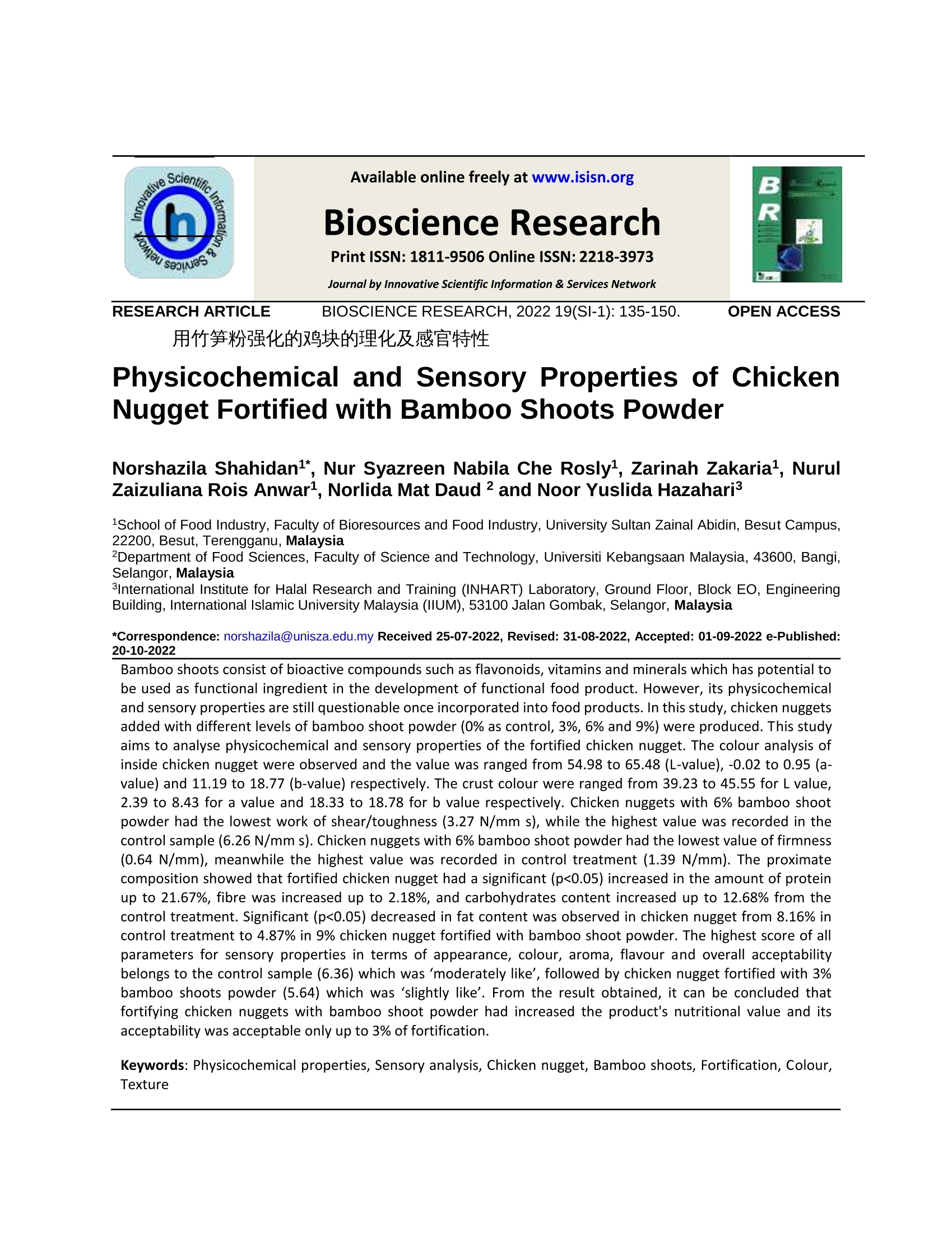
-
2/16
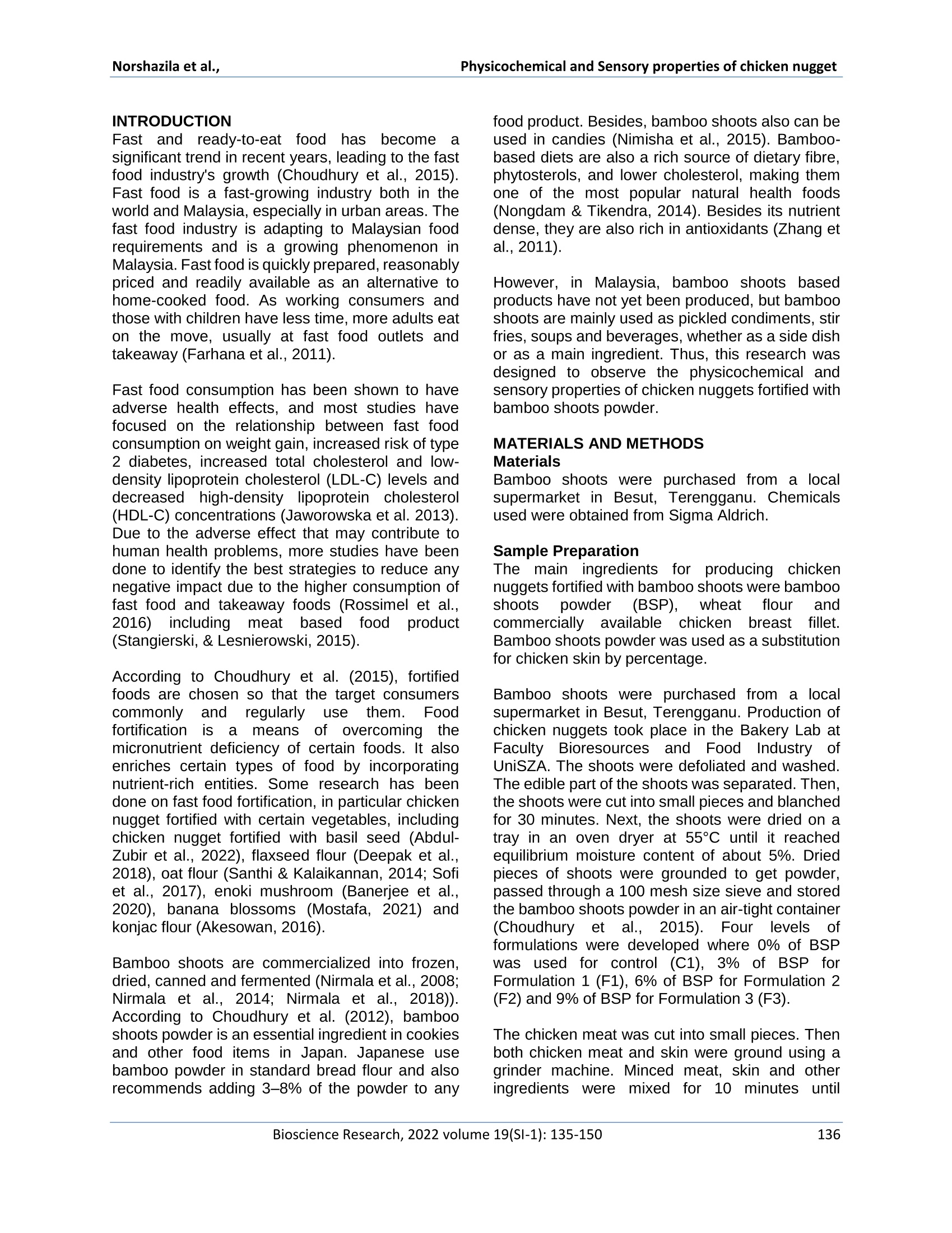
还剩14页未读,是否继续阅读?
继续免费阅读全文产品配置单
中国格哈特为您提供《竹笋粉强化鸡块中蛋白质、脂肪和纤维含量的检测》,该方案主要用于其他肉制品中营养成分检测,参考标准《GB 5009.6 食品中脂肪的测定》,《竹笋粉强化鸡块中蛋白质、脂肪和纤维含量的检测》用到的仪器有格哈特全自动超级总脂肪测定系统HT6+SOX416、格哈特凯氏消化系统KT8S、格哈特维克松废气实验室废物处理系统涤气VS、格哈特全自动型纤维分析仪FT12、格哈特带自动进样器凯氏定氮仪VAP500C、德国加液器MM、滤纸筒。
我要纠错
相关方案


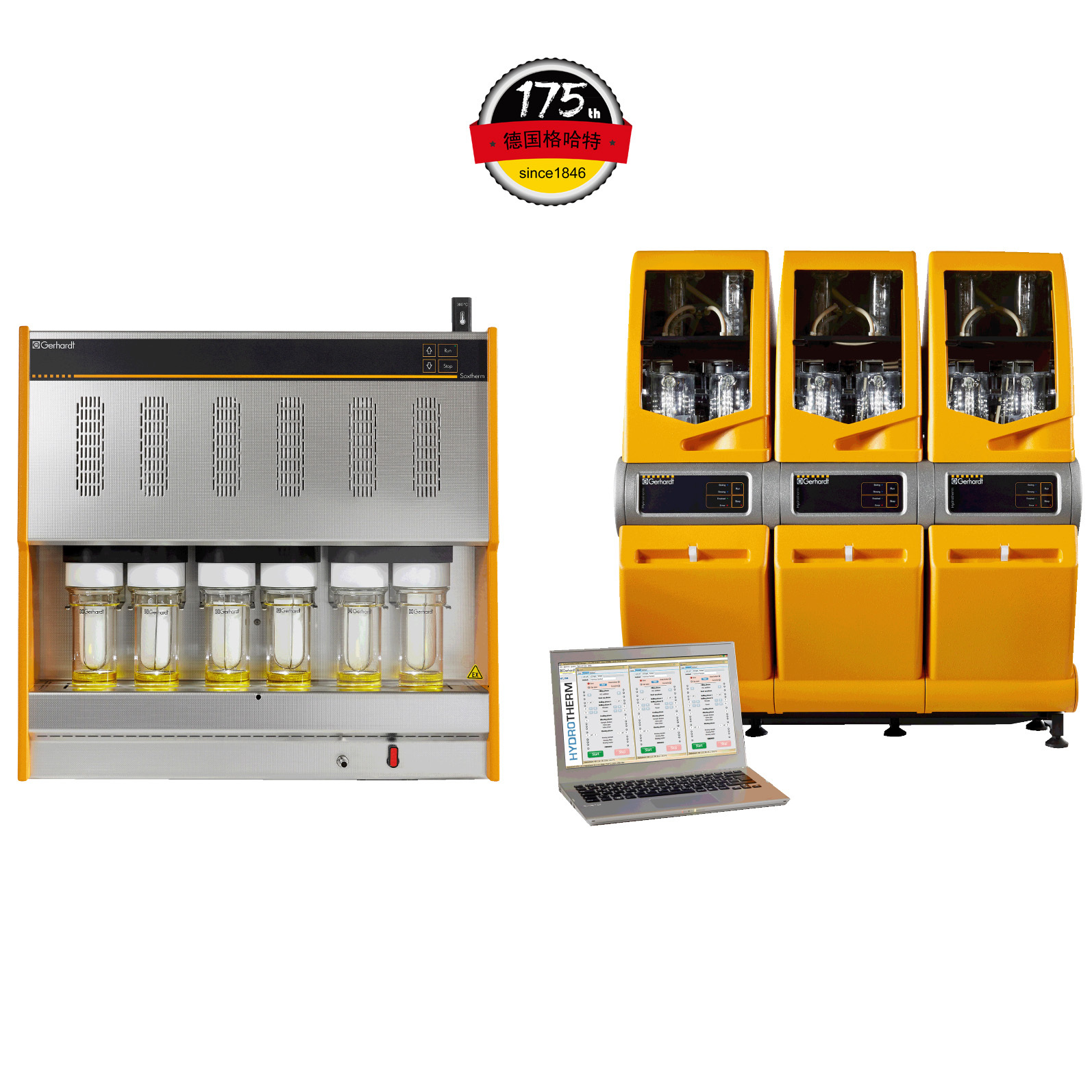
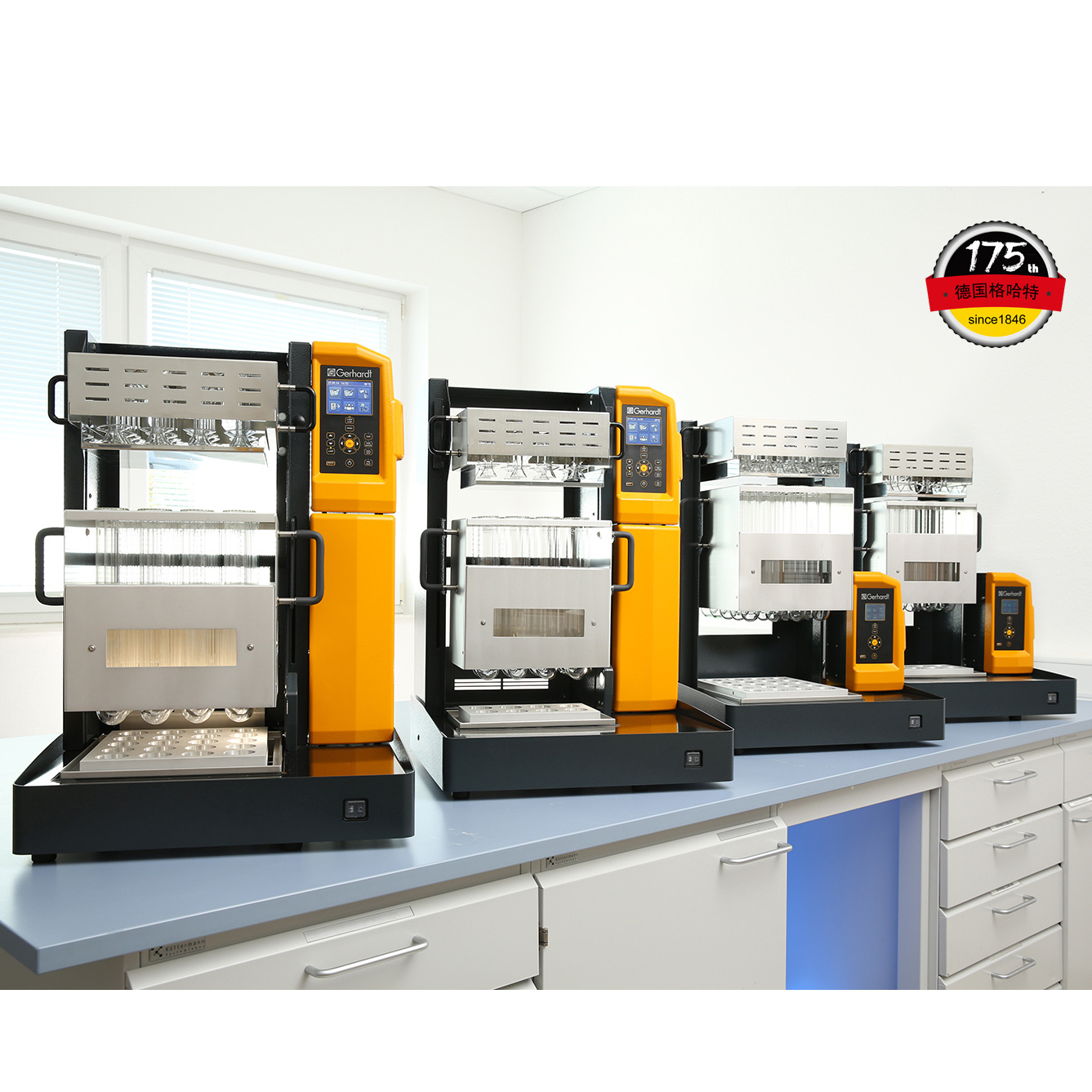
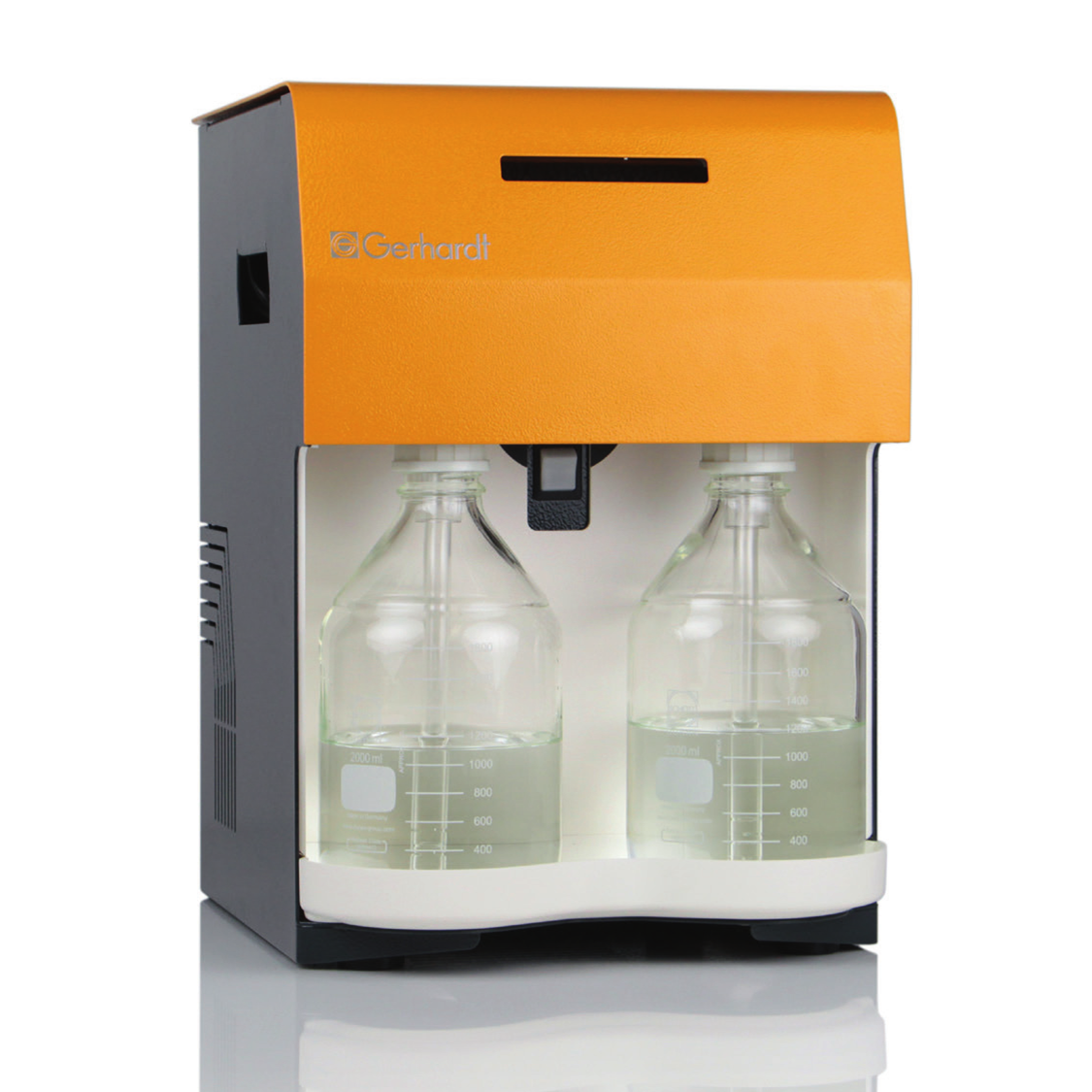

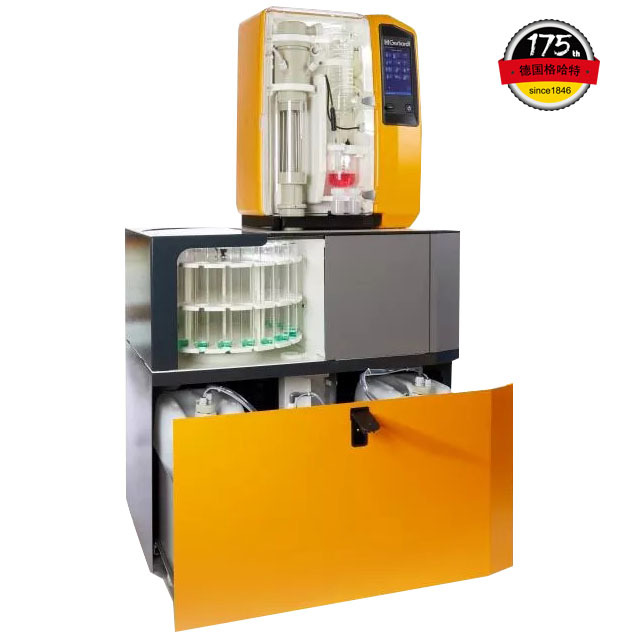
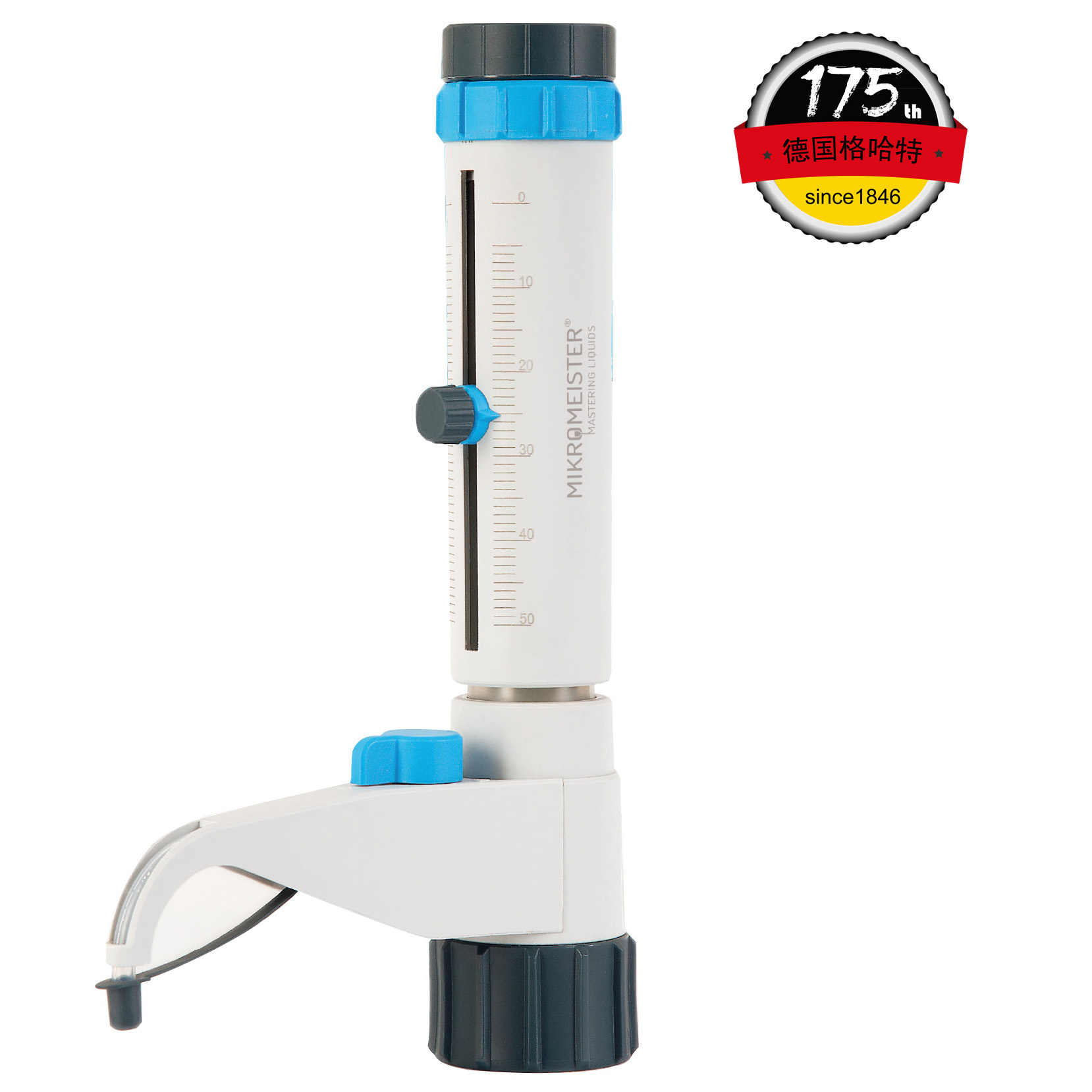
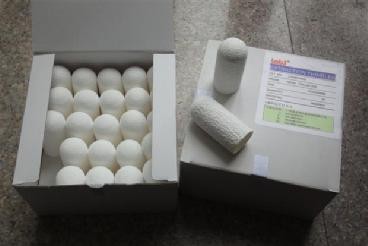

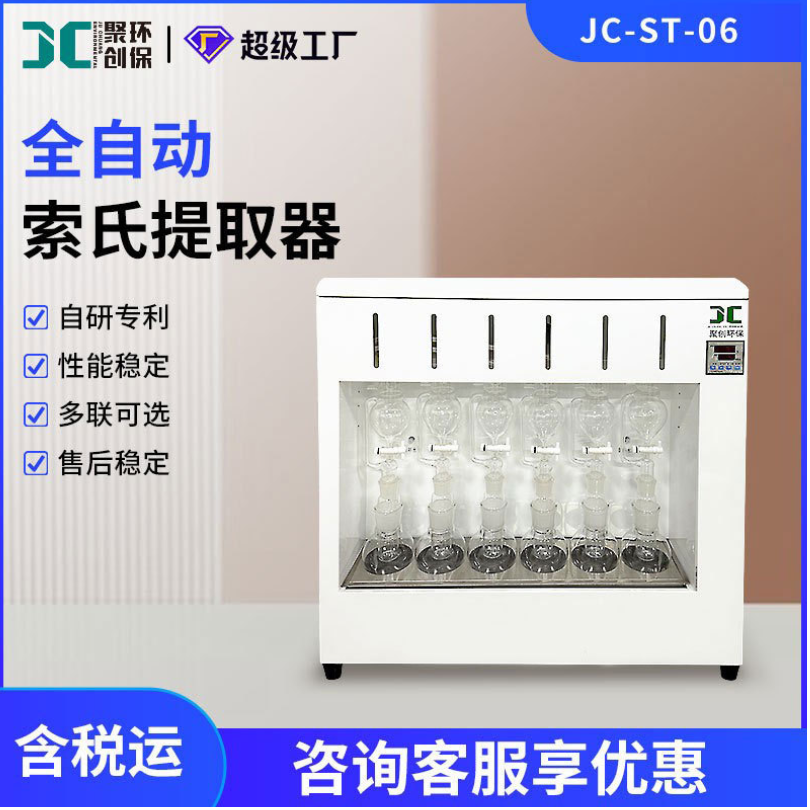

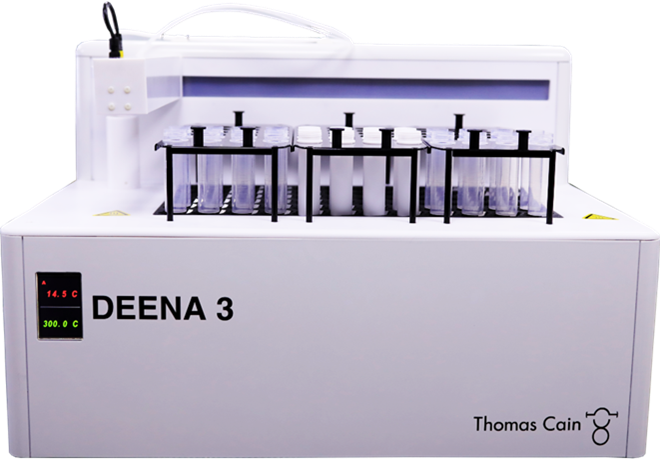

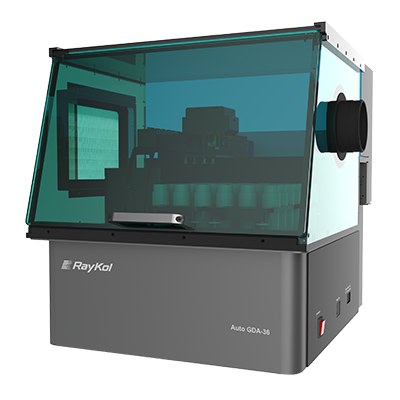
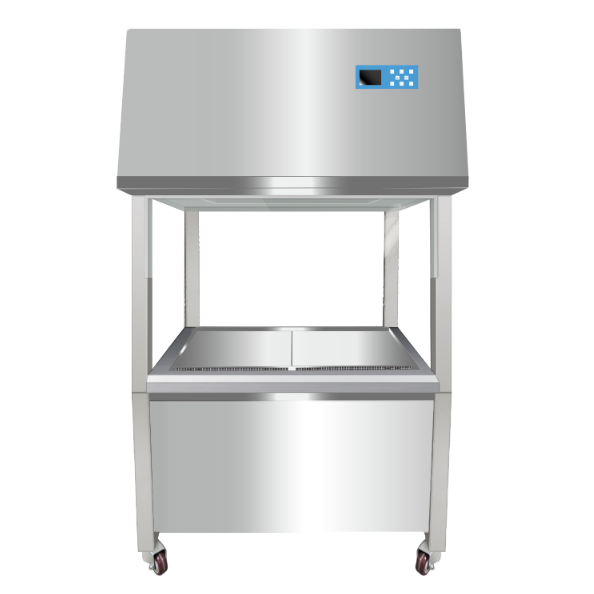


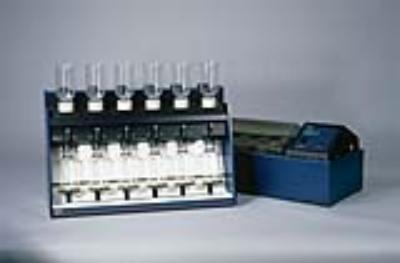

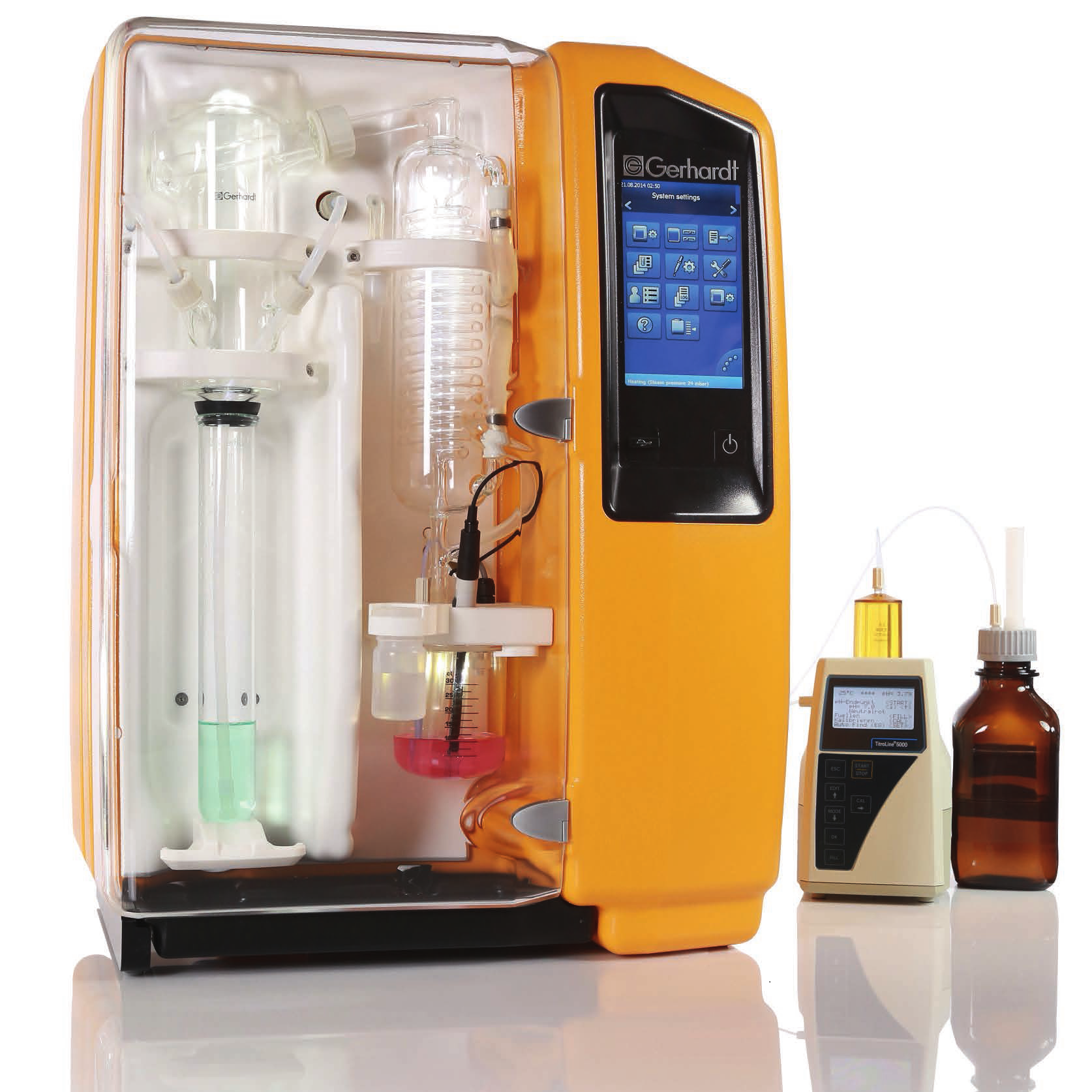




 咨询
咨询